Microstructure and Properties of Semi-Solid 7075 Aluminum Alloy Processed with an Enclosed Cooling Slope Channel
Abstract
1. Introduction
2. Experimental Procedure
2.1. Material
2.2. Production of Semi-Solid Slurry and Rheo-SC
2.3. Microstructure Analysis and Tensile Test
3. Results and Discussion
3.1. Effect of Pouring Temperature on Slurry’s Semi-Solid Microstructure
3.2. Effect of Rate of Cooling Water on Slurry’s Semi-Solid Microstructure
3.3. Microstructure and Mechanical Properties of Casting
3.3.1. Microstructure
3.3.2. Mechanical Properties and Fracture Morphology
4. Conclusions
- (1)
- A pouring temperature of 670 °C and a rate of cooling water of 200 L/h are the ideal preparation conditions for the semi-solid slurry of the 7075 aluminum alloy, at which point the primary α-Al’s average grain diameter is 35 μm, and its shape factor is 0.67.
- (2)
- Rheo-SC improves the microstructure and the homogeneity of the elemental distribution of 7075 aluminum alloys. EBSD analysis showed that the Rheo-SC samples had a much finer microstructure than the LSC samples. The XRD and EDS analyses indicated that the LSC and Rheo-SC samples consisted mainly of two phases: α-Al and MgZn2.
- (3)
- The Rheo-SC samples had ultimate tensile strengths, yield strengths, and elongations that were, respectively, 10%, 10.5%, and 44% higher than those of the liquid squeeze cast. These values were 238 MPa, 151 MPa, and 5.2%. Reduced casting flaws and the combined effects of fine grain strengthening and enhanced segregation were primarily responsible for the performance increase.
Author Contributions
Funding
Data Availability Statement
Acknowledgments
Conflicts of Interest
References
- Dursun, T.; Soutis, C. Recent developments in advanced aircraft aluminium alloys. Mater. Des. 2014, 56, 862–871. [Google Scholar] [CrossRef]
- Hirsch, J. Aluminium in Innovative Light-Weight Car Design. Mater. Trans. 2011, 52, 818–824. [Google Scholar] [CrossRef]
- Hirsch, J. Recent development in aluminium for automotive applications. Trans. Nonferrous Met. Soc. China 2014, 24, 8. [Google Scholar] [CrossRef]
- Kim, S.W.; Kim, D.Y.; Kim, W.G.; Woo, K.D. The study on characteristics of heat treatment of the direct squeeze cast 7075 wrought Al alloy. Mater. Sci. Eng. A-Struct. Mater. Prop. Microstruct. Process. 2001, 304, 721–726. [Google Scholar] [CrossRef]
- Li, C.; Wu, S.S.; Lu, S.L.; Li, J.Y.; Liu, L.F.; Xia, L.Q. Effects of Excessive Zr Content and Ultrasonic Treatment on Microstructure and Mechanical Properties of Al-Zn-Mg-Cu Alloy. Metals 2021, 11, 13. [Google Scholar] [CrossRef]
- Li, F.; Peh, W.Y.; Nagarajan, V.; Ho, M.K.; Danno, A.; Chua, B.W.; Tan, M.J. Development of non-flammable high strength AZ91+Ca alloys via liquid forging and extrusion. Mater. Des. 2016, 99, 37–43. [Google Scholar] [CrossRef]
- Dasgupta, R.; Xia, Y. Squeeze Casting: Principles and Applications. 2004. Available online: https://www.researchgate.net/publication/295555574_Squeeze_casting_Principles_and_applications (accessed on 12 March 2023).
- Li, R.X.; Liu, L.J.; Zhang, L.J.; Sun, J.H.; Shi, Y.J.; Yu, B.Y. Effect of Squeeze Casting on Microstructure and Mechanical Properties of Hypereutectic Al-xSi Alloys. J. Mater. Sci. Technol. 2017, 33, 404–410. [Google Scholar] [CrossRef]
- Lu, S.L.; Wu, S.S.; Zhu, Z.M.; An, P.; Mao, Y.W. Effect of semi-solid processing on microstructure and mechanical properties of 5052 aluminum alloy. Trans. Nonferrous Met. Soc. China 2010, 20, S758–S762. [Google Scholar] [CrossRef]
- Xiao, G.F.; Jiang, J.F.; Liu, Y.Z.; Wang, Y.; Guo, B.Y. Recrystallization and microstructure evolution of hot extruded 7075 aluminum alloy during semi-solid isothermal treatment. Mater. Charact. 2019, 156, 13. [Google Scholar] [CrossRef]
- Zhou, B.; Shuai, L.U.; Kai-Le, X.U.; Chun, X.U.; Wang, Z.Y.; Wang, B.J. Hot cracking tendency test and simulation of 7075 semi-solid aluminium alloy. Trans. Nonferrous Met. Soc. China 2020, 30, 318–332. [Google Scholar] [CrossRef]
- Flemings, M.C.; Riek, R.G.; Young, K.P. Rheocasting. Mater. Sci. Eng. 1976, 25, 103–117. [Google Scholar] [CrossRef]
- Liu, Y.; Gao, M.Q.; Meng, S.C.; Fu, Y.; Li, W.R.; Li, C.H.; Guan, R.G. Solidification behavior and enhanced properties of semi-solid Al-8Si-0.5Fe alloys fabricated by rheo-diecasting. J. Mater. Res. Technol. JMRT 2022, 19, 3160–3171. [Google Scholar] [CrossRef]
- Qi, M.F.; Xu, Y.Z.; Li, J.Y.; Kang, Y.L.; Wulabieke, Z. Microstructure refinement and corrosion resistance improvement mechanisms of a novel Al-Si-Fe-Mg-Cu-Zn alloy prepared by ultrasonic vibration-assisted rheological die-casting process. Corros. Sci. 2021, 180, 14. [Google Scholar] [CrossRef]
- Gao, W.J.; Xing, S.M.; Yan, G.Y.; Zhao, B.W. Effect of oscillation frequency on microstructure of A356 slurry prepared by semi-solid metal forming with flow. J. Mater. Process. Technol. 2023, 311, 13. [Google Scholar] [CrossRef]
- Zhou, B.; Qiu, Z.Y.; Chen, K.P.; Xu, C.; Wang, Z.Y. Microstructure, Properties, and Numerical Simulation of Semi-Solid Aluminum Alloy under Planetary Stirring Process. Materials 2022, 15, 12. [Google Scholar] [CrossRef]
- Jahanbakhshi, M.; Nourouzi, S.; Naseri, R.; Esfandiari, K. Investigation of Simultaneous Effects of Cooling Slope Casting and Mold Vibration on Mechanical and Microstructural Properties of A356 Aluminum Alloy. Met. Mater. Int. 2022, 28, 1508–1516. [Google Scholar] [CrossRef]
- Li, Y.K.; Zhou, R.F.; Li, L.; Xiao, H.; Jiang, Y.H. Microstructures formation, distribution of tin element and properties of CuSn10P1 alloy during controlled by melt cooling. Mater. Res. Express 2018, 5, 11. [Google Scholar] [CrossRef]
- Zhang, L.J.; Fan, J.T.; Liu, D.J.; Zhang, M.D.; Yu, P.F.; Jing, Q.; Ma, M.Z.; Liaw, P.K.; Li, G.; Liu, R.P. The microstructural evolution and hardness of the equiatomic CoCrCuFeNi high-entropy alloy in the semi-solid state. J. Alloys Compd. 2018, 745, 75–83. [Google Scholar] [CrossRef]
- Wang, Y.F.; Zhao, S.D.; Zhang, C.Y. Microstructures and mechanical properties of semi-solid squeeze casting ZL104 connecting rod. Trans. Nonferrous Met. Soc. China 2018, 28, 235–243. [Google Scholar] [CrossRef]
- Li, Y.K.; Zhou, R.F.; Li, L.; Xiao, H.; Jiang, Y.H. Microstructure and Properties of Semi-solid ZCuSn10P1 Alloy Processed with an Enclosed Cooling Slope Channel. Metals 2018, 8, 11. [Google Scholar] [CrossRef]
- Li, N.Y.; Mao, W.M.; Geng, X.X. Preparation of semi-solid 6061 aluminum alloy slurry by serpentine channel pouring. Trans. Nonferrous Met. Soc. China 2022, 32, 739–749. [Google Scholar] [CrossRef]
- Das, P.; Samanta, S.K.; Bera, S.; Dutta, P. Microstructure Evolution and Rheological Behavior of Cooling Slope Processed Al-Si-Cu-Fe Alloy Slurry. Metall. Mater. Trans. A-Phys. Metall. Mater. Sci. 2016, 47A, 2243–2256. [Google Scholar] [CrossRef]
- Guan, R.G.; Wang, C.; Shang, J.H.; Xing, Z.H. Semisolid metal forming by novel sloping plate process. Trans. Nonferrous Met. Soc. China 2006, 16, S1265–S1269. [Google Scholar] [CrossRef]
- Li, M.; Li, Y.D.; Zheng, H.Q.; Huang, X.F.; Chen, T.J.; Ma, Y. Solidification behavior of 6061 wrought aluminum alloy during rheo-diecasting process with self-inoculation method. Trans. Nonferrous Met. Soc. China 2018, 28, 879–889. [Google Scholar] [CrossRef]
- Chapman, B. Heat transfer. Magn. Reson. Mater. Biol. Phys. Med. 1974, 9, 146–151. [Google Scholar] [CrossRef]
- Liu, Z.Y.; Mao, W.M.; Wan, T.; Cui, G.T.; Wang, W.P. Study on Semi-Solid A380 Aluminum Alloy Slurry Prepared by Water-Cooling Serpentine Channel and Its Rheo-Diecasting. Met. Mater. Int. 2021, 27, 2067–2077. [Google Scholar] [CrossRef]
- Jian, Z.Y.; Chang, F.G.; Yan, W.; Yang, G.C.; Zhou, Y.H. Determination of the critical nucleation frequency in undercooled metal melt. Prog. Nat. Sci. 2000, 10, 211–217. [Google Scholar]
- Dong, X.X.; Yang, H.L.; Zhu, X.Z.; Ji, S.X. High strength and ductility aluminium alloy processed by high pressure die casting. J. Alloys Compd. 2019, 773, 86–96. [Google Scholar] [CrossRef]
- Guan, R.G.; Zhao, Z.Y.; Li, Y.D.; Chen, T.J.; Xu, S.X.; Qi, P.X. Microstructure and properties of squeeze cast A356 alloy processed with a vibrating slope. J. Mater. Process. Technol. 2016, 229, 514–519. [Google Scholar] [CrossRef]
- Li, Y.K.; Li, L.; Geng, B.Y.; Wang, Q.P.; Zhou, R.F.; Wu, X.; Xiao, H. Microstructure characteristics and strengthening mechanism of semisolid CuSn10P1 alloys. Mater. Charact. 2021, 172, 11. [Google Scholar] [CrossRef]
- Chang, Z.Y.; Deng, Q.C.; Lan, Q.; Feng, J.; Li, D.Q.; Liu, B.L.; Wu, Y.J.; Peng, L.M.; Ding, W.J. Microstructure and mechanical properties of Mg-Gd-Y-Zn-Zr alloy prepared by rheo-diecasting. Mater. Sci. Eng. A-Struct. Mater. Prop. Microstruct. Process. 2022, 848, 10. [Google Scholar] [CrossRef]
- Wei, Z.Y.; Yuan, M.N.; Shen, X.Q.; Han, F.Z.; Yao, Y.H.; Xin, L.; Yao, L.B. EBSD investigation on the interface microstructure evolution of Ti-Al3Ti laminated composites during the preparation process. Mater. Charact. 2020, 165, 9. [Google Scholar] [CrossRef]
- Li, N.Y.; Mao, W.M.; Geng, X.X.; Zhang, R.S.; Yan, B.D. Microstructure, segregation and fracture behavior of 6061 aluminum alloy samples formed by semi-solid or traditional high pressure die casting. Mater. Today Commun. 2022, 31, 16. [Google Scholar] [CrossRef]
- Mahathaninwong, N.; Plookphol, T.; Wannasin, J.; Wisutmethangoon, S. T6 heat treatment of rheocasting 7075 Al alloy. Mater. Sci. Eng. A-Struct. Mater. Prop. Microstruct. Process. 2012, 532, 91–99. [Google Scholar] [CrossRef]
- Baek, M.S.; Euh, K.; Lee, K.A. Microstructure, tensile and fatigue properties of high strength Al 7075 alloy manufactured via twin-roll strip casting. J. Mater. Res. Technol. JMRT 2020, 9, 9941–9950. [Google Scholar] [CrossRef]
- Wang, X.D.; Zhang, Z.; Wang, Z.B.; Ren, X.C. Excellent tensile property and its mechanism in Al0.3CoCrFeNi high-entropy alloy via thermo-mechanical treatment. J. Alloys Compd. 2022, 897, 10. [Google Scholar] [CrossRef]
- Xiong, Z.F.; Jiang, Y.; Yang, M.; Zhang, Y.; Lei, L. Achieving superior strength and ductility in 7075 aluminum alloy through the design of multi-gradient nanostructure by ultrasonic surface rolling and aging. J. Alloys Compd. 2022, 918, 14. [Google Scholar] [CrossRef]
- Qi, M.F.; Kang, Y.L.; Xu, Y.Z.; Wulabieke, Z.; Li, J.Y. A novel rheological high pressure die-casting process for preparing large thin-walled Al-Si-Fe-Mg-Sr alloy with high heat conductivity, high plasticity and medium strength. Mater. Sci. Eng. A-Struct. Mater. Prop. Microstruct. Process. 2020, 776, 18. [Google Scholar] [CrossRef]
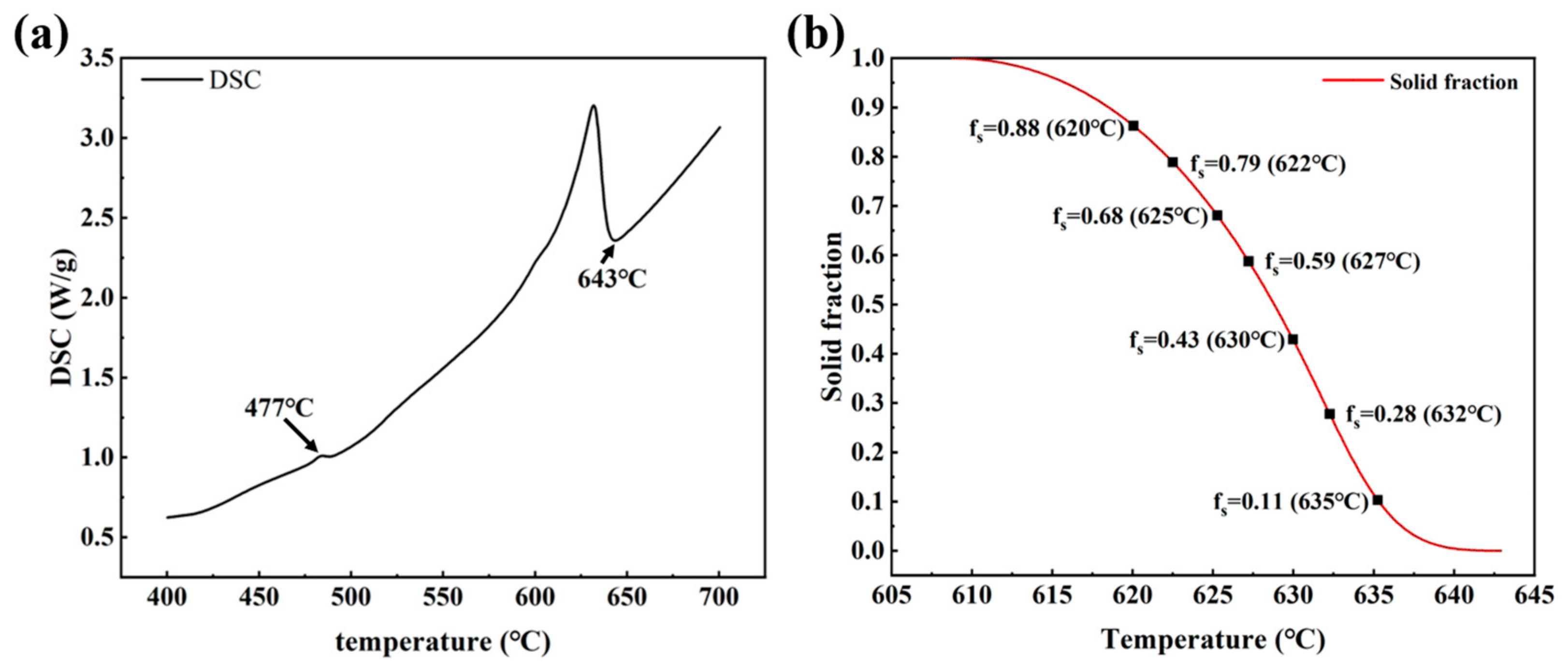



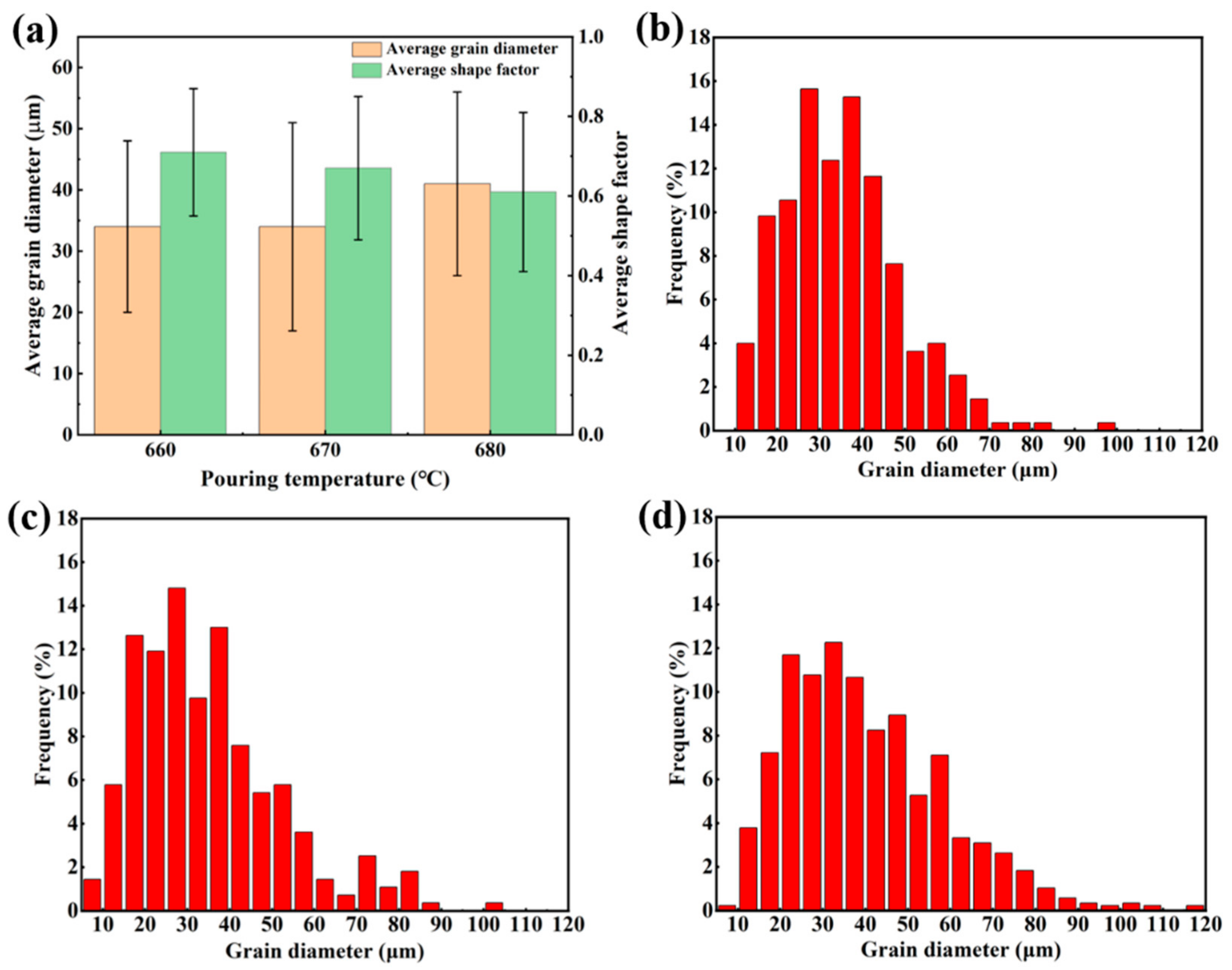



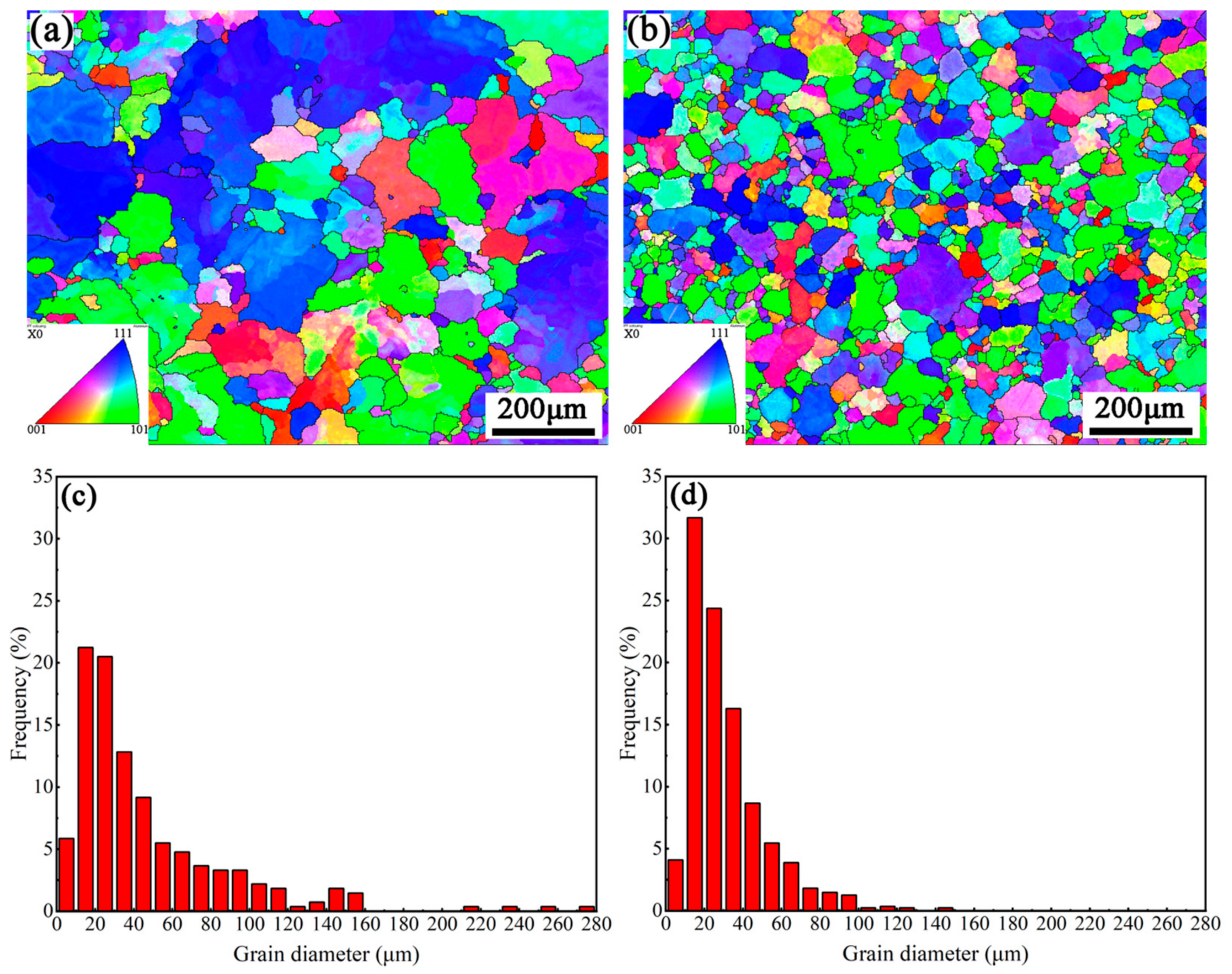
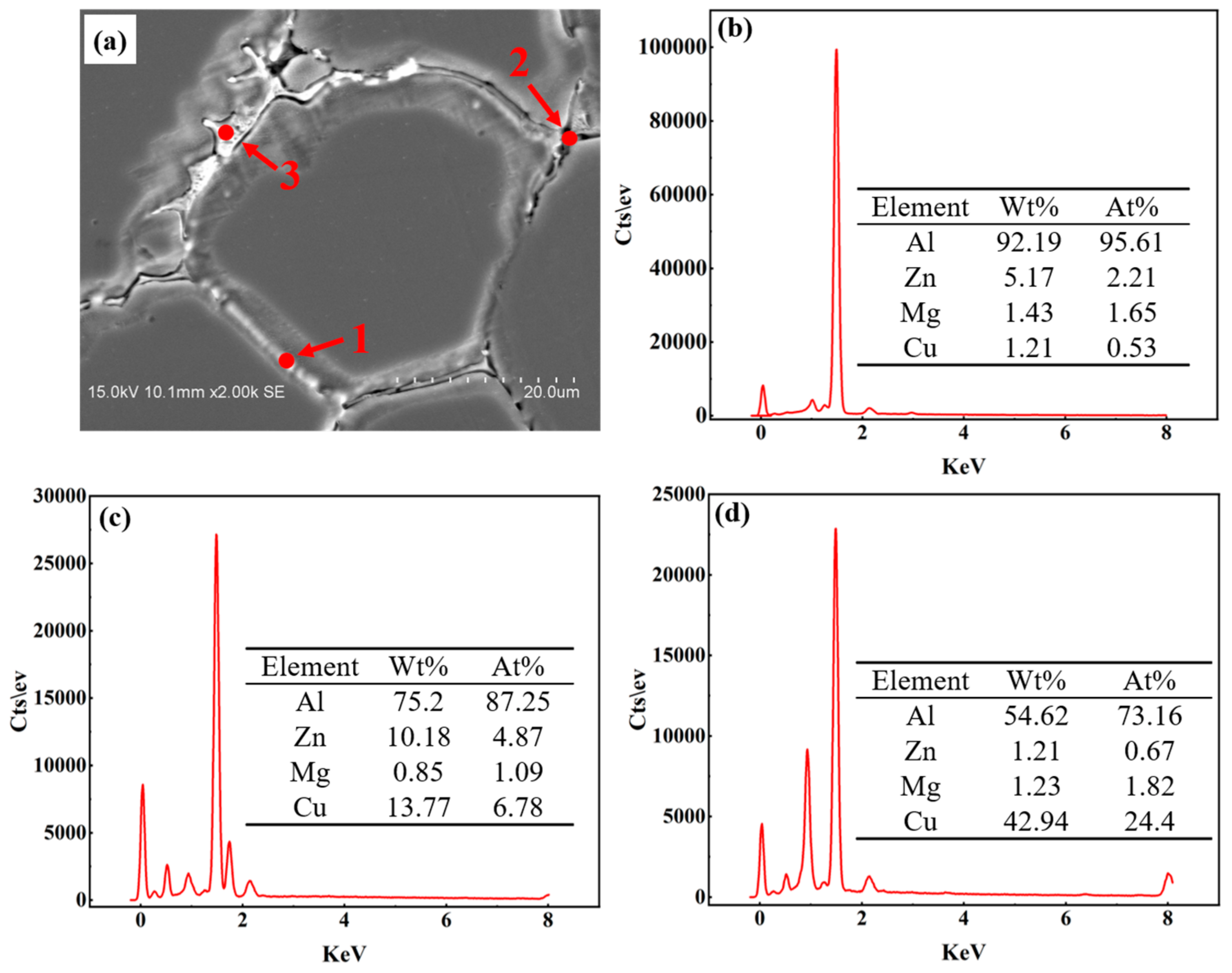
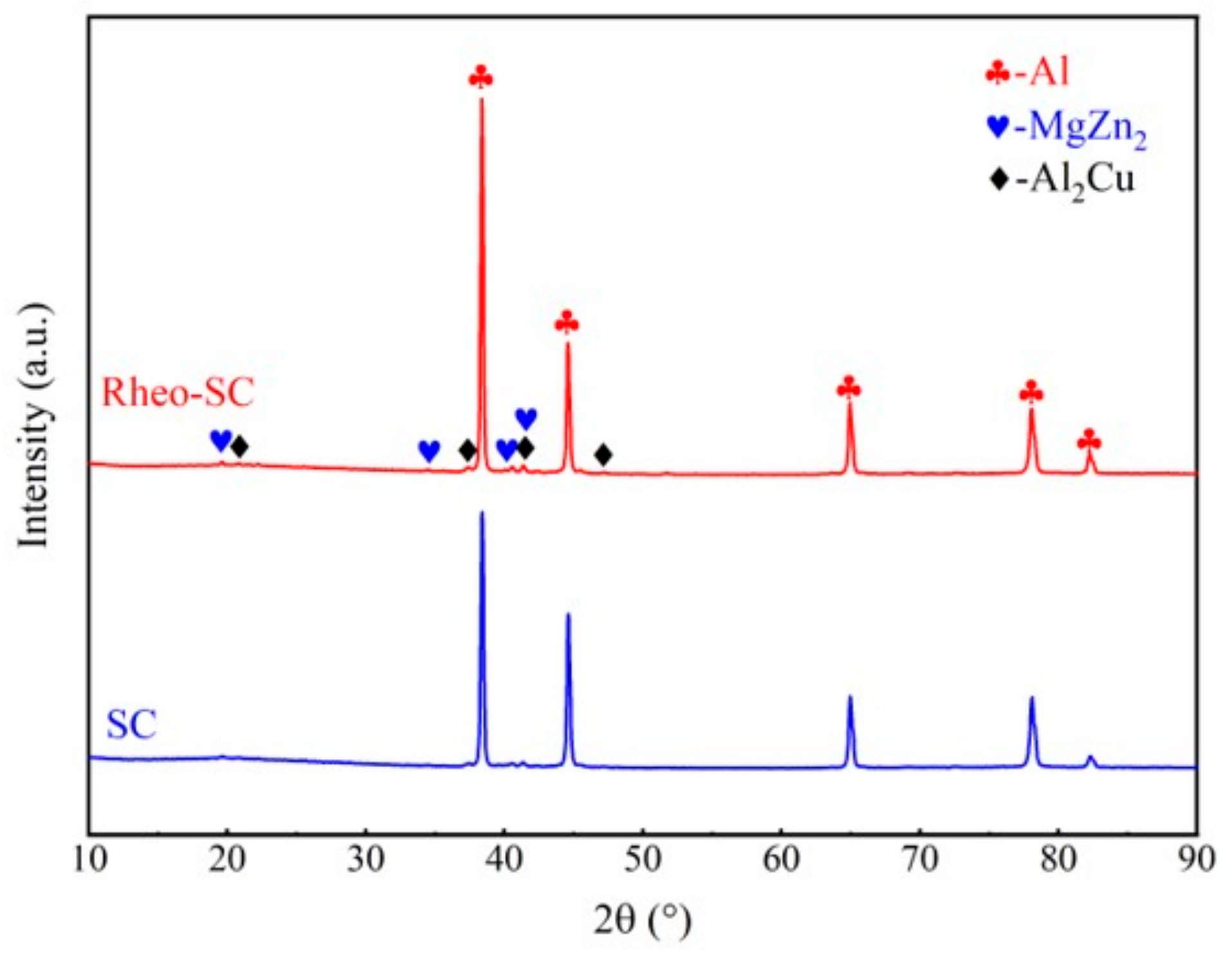
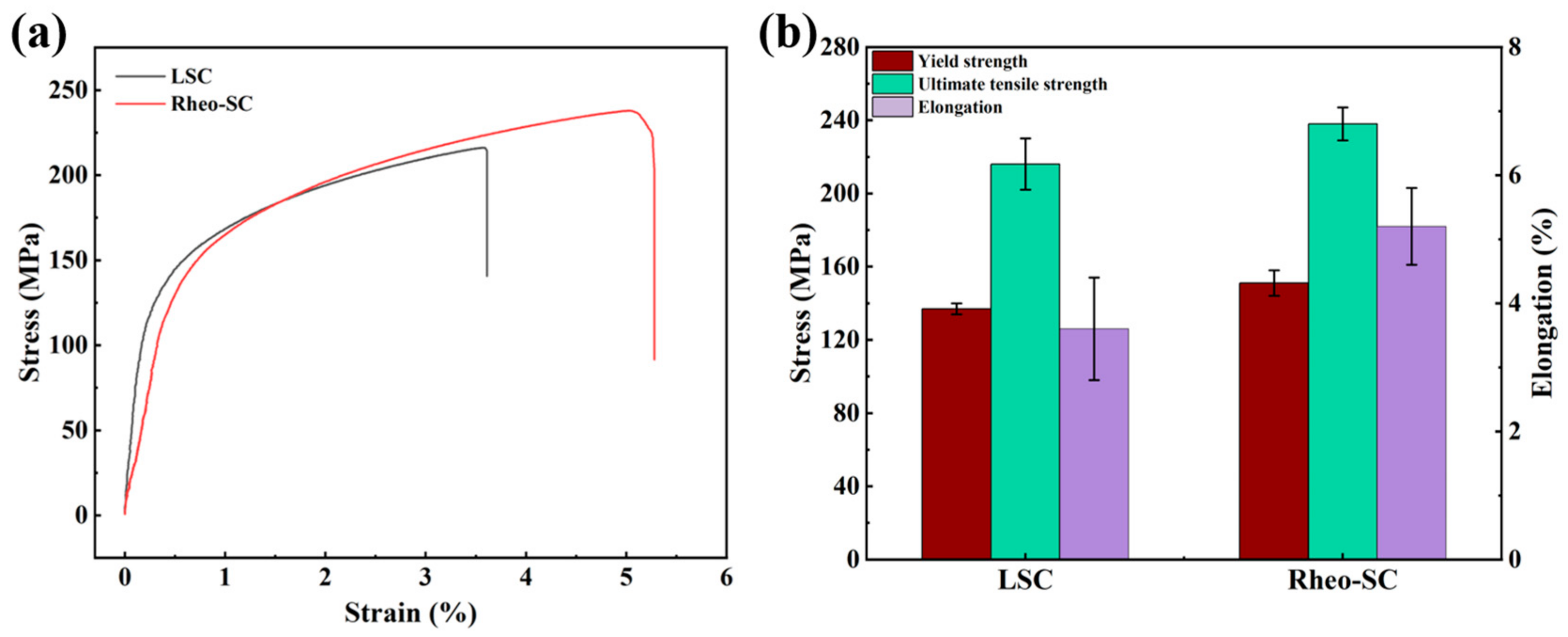
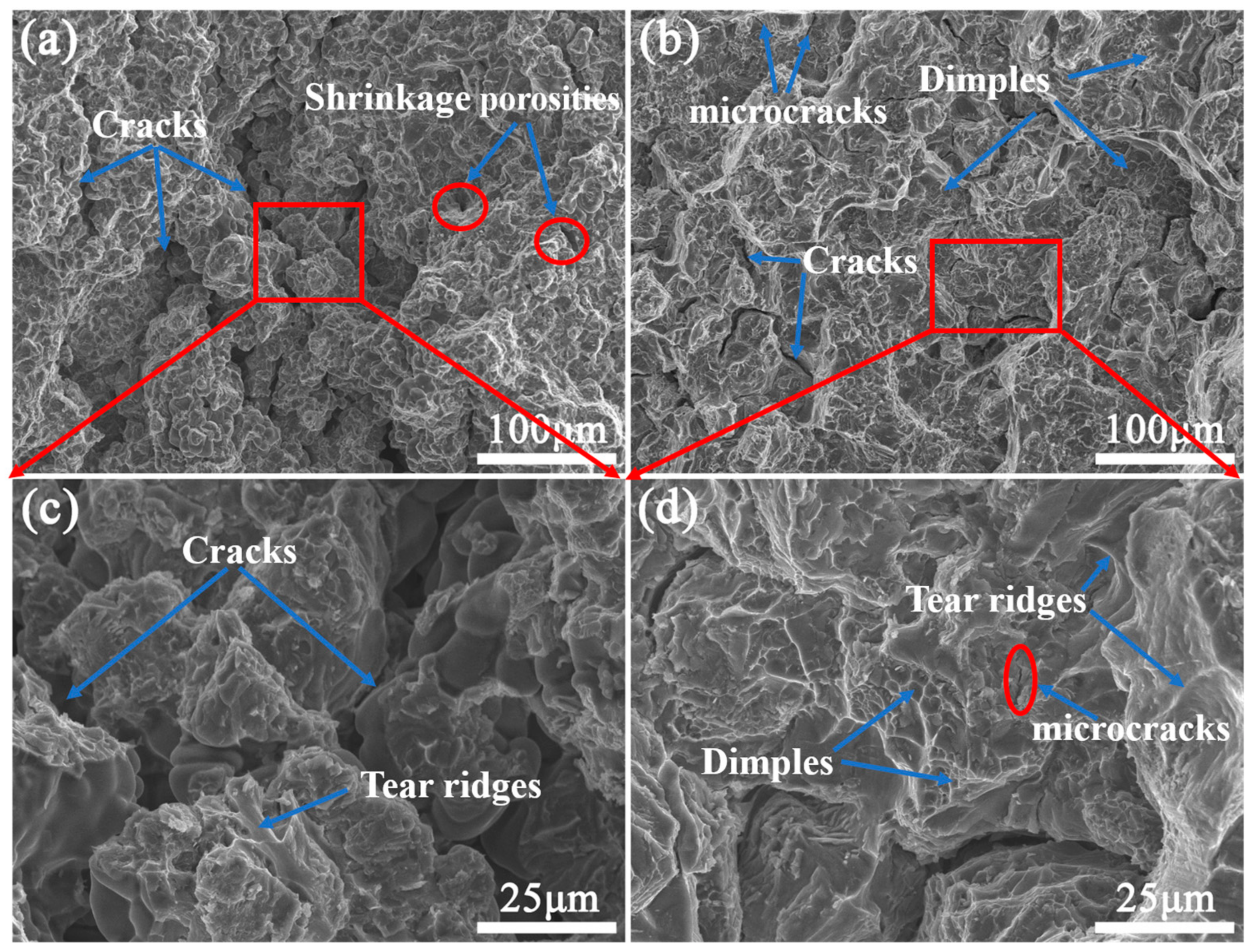
| No. | Pouring Temperature (°C) | Rate of Cooling Water (L/h) | Outlet Temperature (°C) | Average Grain Diameter (μm) | Average Shape Factor |
|---|---|---|---|---|---|
| 1 | 660 | 200 | 627 | 34 ± 14 | 0.71 ± 0.16 |
| 2 | 670 | 200 | 629 | 35 ± 17 | 0.67 ± 0.18 |
| 3 | 680 | 200 | 634 | 41 ± 15 | 0.61 ± 0.20 |
| 4 | 670 | 100 | 631 | 42 ± 23 | 0.56 ± 0.21 |
| 5 | 670 | 300 | 625 | 36 ± 19 | 0.64 ± 0.19 |
Disclaimer/Publisher’s Note: The statements, opinions and data contained in all publications are solely those of the individual author(s) and contributor(s) and not of MDPI and/or the editor(s). MDPI and/or the editor(s) disclaim responsibility for any injury to people or property resulting from any ideas, methods, instructions or products referred to in the content. |
© 2023 by the authors. Licensee MDPI, Basel, Switzerland. This article is an open access article distributed under the terms and conditions of the Creative Commons Attribution (CC BY) license (https://creativecommons.org/licenses/by/4.0/).
Share and Cite
Li, Z.; Li, Y.; Zhou, R.; Xie, L.; Wang, Q.; Zhang, L.; Ji, Q.; Xu, B. Microstructure and Properties of Semi-Solid 7075 Aluminum Alloy Processed with an Enclosed Cooling Slope Channel. Crystals 2023, 13, 1102. https://doi.org/10.3390/cryst13071102
Li Z, Li Y, Zhou R, Xie L, Wang Q, Zhang L, Ji Q, Xu B. Microstructure and Properties of Semi-Solid 7075 Aluminum Alloy Processed with an Enclosed Cooling Slope Channel. Crystals. 2023; 13(7):1102. https://doi.org/10.3390/cryst13071102
Chicago/Turabian StyleLi, Zhaoqiang, Yongkun Li, Rongfeng Zhou, Lingzhi Xie, Qiansi Wang, Lingzhi Zhang, Qiang Ji, and Bin Xu. 2023. "Microstructure and Properties of Semi-Solid 7075 Aluminum Alloy Processed with an Enclosed Cooling Slope Channel" Crystals 13, no. 7: 1102. https://doi.org/10.3390/cryst13071102
APA StyleLi, Z., Li, Y., Zhou, R., Xie, L., Wang, Q., Zhang, L., Ji, Q., & Xu, B. (2023). Microstructure and Properties of Semi-Solid 7075 Aluminum Alloy Processed with an Enclosed Cooling Slope Channel. Crystals, 13(7), 1102. https://doi.org/10.3390/cryst13071102







